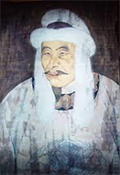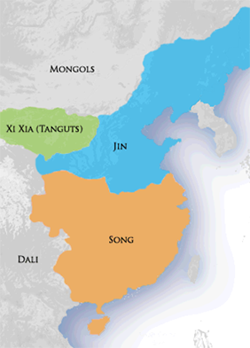China's Great Jin Dynasty
The Jin Dynasty arose out of what is now Manchuria and threw off two rival powers, ruling much of northern China for more than a century, before bowing to the might of the Mongols. 
The Jurchens lived under the yoke of the Liao state for many years before rebelling against them. The tribal chieftain Aguda (right) in 1115 declared himself and his people free from Liao influence and resolved to fight to prove it. Aguda, as the leader of the new Jin Dynasty (often called the Great Jin Dynasty, to differentiate it from the earlier Jin Dynasty), and his people fought the Liao for a time and then gained a powerful ally, the Song Dynasty. That alliance was powerful enough to drive the Liao forces to the west, leaving the Jin in control of the north. 
Aguda died in 1125, and his successor threw off the alliance with the Song and invaded Song China. The Jin were initially very successful, taking the Song capital of Kaifeng in 1127. Jin and Song continued to fight for another 14 years, until they agreed to the 1141 Treaty of Shaoxing. A subsequent Jin emperor, Wanyan Liang, moved the Jin capital to Yanjing, the former Liao capital (and what is today Beijing), and also restored Kaifeng, which Jin armies had sacked in 1127. He then broke the truce with the Song and renewed the war. This time, Song armies were up to the task, inflicting heavy casualties on the Jin in two significant defeats in 1161, at the Battle of Caishi and the Battle of Tangdao. The emperor's own generals ended his life, and a subsequent ruler began peace negotiations. The second agreement between Jin and Song, the 1164 Treaty of Longxing, was a lasting one. By this time, Shizong was emperor of Jin lands. He encouraged the sharing of resources, lowered taxes on farming, and founded the Jurchen Academy to remind his people of their traditions. The Jin enjoyed economic prosperity and trade with neighbors, in a time of relative peace. A Song surprise attack in the early 13th Century came to nothing, and Song forces again sued for peace. Jin armies had much less success against another invader, the Mongols. 
The venerable Genghis Khan led a Mongol horde of 50,000 into Jin lands in 1211. They succeeded in taking much Jin land and dispatching many Jin soldiers. While war with the Mongols raged, Jin forces inexplicably attacked to the south, into Song lands, as well. Song armies quickly allied with Mongol armies, and that alliance crushed Jin resistance. A Mongol siege of Kaifeng in 1233 forced then-Emperor Aizong to flee to Caizhou, in the south. A year later, the Mongol army took that city, too. The Jin Dynasty was at an end. Jin successes on the field of battle were mainly in struggles between armies. The Song constructed the first permanent navy and had great success against the Jin, in those twin battles in 1161. It was during the Mongol siege of Kaifeng in 1233 that Jin armies first deployed gunpowder weapons, including cannons, grenades, and small rockets. 
Against the invading Mongols, Jin workers constructed two significant portions of the Great Wall. Known as the Jin Great Wall, it was a system of walls, forts, beacon towers, and watchtowers. Outside all of that was a trench, dug to stop attacks on horseback, a specialty of the Mongols. Some places had two trenches and two sets of walls. As in China, Confucianism and Taoism held sway in mystical matters, although Buddhism gained in popularity in the later Jin years.
|
|
Social Studies for Kids
copyright 2002–2025
David White




